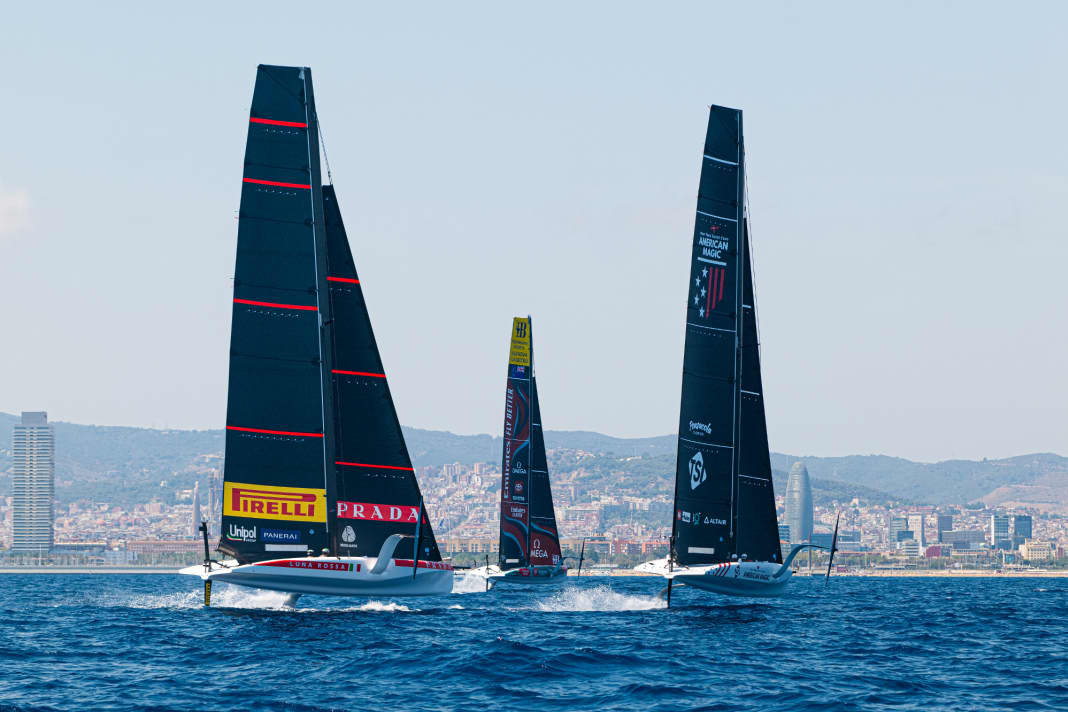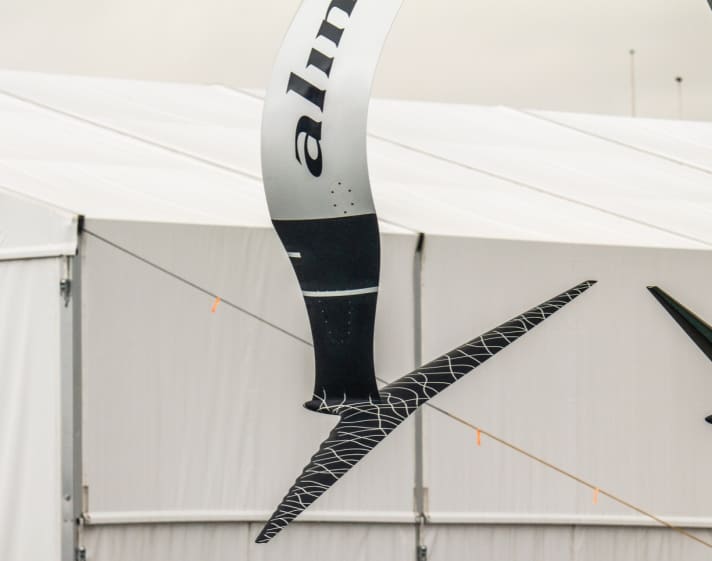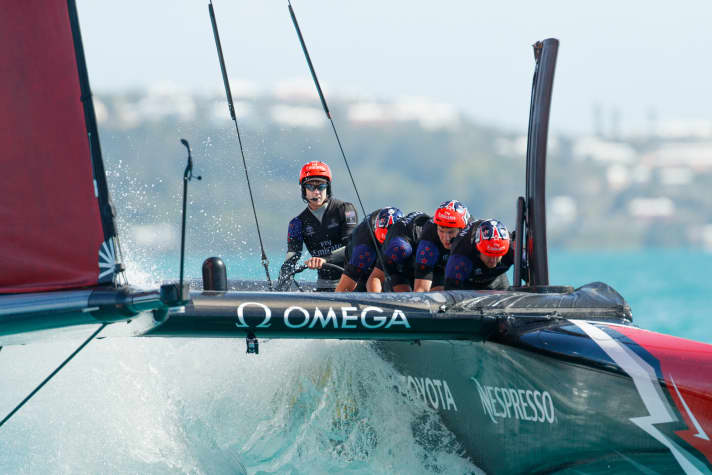America's Cup: 30 days until the first pre-regatta - several boats already at the start for the first time
Max Gasser
· 15.08.2023






The battle for the world's oldest sporting trophy will begin on 14 September. That is when the starting signal will be given for the first of three preliminary regattas off Vilanova i la Geltrú (Spain). The preliminary regattas will take place in a mixed format of fleet and match racing. The first two events will be sailed with the One Design AC40s, so the clear focus will be on the performance of the sailors.
After a training day on 14 September, the races will start one day later directly in front of the harbour entrance in a spectator-friendly setting, with free access for visitors. In addition, the four-day kick-off will be available free of charge on YouTube and the America's Cup website. To ensure that everything runs smoothly, trial runs with several boats on the starting line were carried out for the first time last week.
Although pre-regattas only serve as a warm-up for the decisive Challenger Selection Series However, for the first time, the races will provide a real opportunity to determine where they stand in a direct comparison. For the very first time, all six confirmed participants in the 37th America's Cup will meet in the races, which will be held directly in front of the harbour entrance for spectators. What has already happened before the first showdown? How far are the teams on their way to their goal of lifting the prestigious trophy into the Barcelona sky in October 2024?
"What we have achieved so far is not nearly enough to win the America's Cup," said Emirates Team New Zealand's COO Kevin Shoebridge just a few weeks ago. Shortly beforehand, the New Zealanders had launched their AC75 "Te Rehutai" in Barcelona to test in the Cup area for the first time. During the first sessions, however, the defenders looked anything but unprepared. On the contrary: they really got going and set a real exclamation mark on the second training day of the five-month programme in Barcelona. The helmsmen and Olympic champions Nathan Outteridge and Peter Burling cut sharp tacks and gybes with an impressive foil-to-foil rate of around 85 per cent each on Sunday in winds of between 6 and 13 knots, and the stability of the AC75 in flight was also outstanding. "We are very happy with how the boats are running and how everyone is settling in," summarised Burling after the successful session.
America's Cup: New Zealanders set standards
In addition to the revised AC75 from the last edition of the Cup, the team also operates two AC40s. The smaller version with a four-man crew will not only be used in the Women's and Youth America's Cup, but also in the first two events of the Preliminary Regattas. In addition, the one-design foils serve as a test platform for most teams, for example for new foils. According to the current regulations, each team is only allowed to build one cupper; new full-size training boats are not permitted.
The Swiss team Alinghi Red Bull Racing is using a similar model for its America's Cup comeback. After victories in 2003 and 2007 and a further participation in Valencia in 2010, the team will once again be among the favourites in the 37th edition. Also with an AC75 - "BoatZero" is an old training boat of the New Zealanders - the Swiss were the first team to present a training boat for the current campaign back in August 2022. They decided to set up their base directly in the actual Cup area and could therefore benefit from a small "home advantage", especially at the start in a month's time. After all, Vilanova i la Geltrú is only around 45 kilometres from Barcelona.
- America's Cup: Alinghi brought the silver jug to Europe for the first time 20 years ago
- Alinghi Red Bull Racing in Barcelona with "BoatZero" on course for the America's Cup
Taking a leaf out of the humpback whale's book: Alinghi tests tubercle foil
The red bulls now also have two AC40s, one of which has recently been heavily used as a Leq12 test platform. One delta-shaped foil in particular, which was also fitted with tubercles on one side, caused quite a stir. The protrusions on the leading edge of the wing were intended to increase its hydrodynamic performance. This technology was inspired by research on humpback whales, which have such tubercles on the leading edge of their flippers. They enable the humpback whale to be very manoeuvrable for its size. The effect is not entirely new in the history of the America's Cup and has also been used in other areas. In aircraft, for example, similar tubercles can improve manoeuvrability and buoyancy and delay stalling.

The position of the tubercles on the foil also allows the position of the cavitation to be manipulated, which may have been one of the goals of the Alinghi engineers. In addition, the increased buoyancy during the manoeuvres flown could be a decisive factor. However, the tubercle foil was replaced by the one-design foil after an initial test phase, and the sailors have not yet made any binding statements about its performance. The idea could therefore have already been discarded or may already be undergoing further development.
Even though the foils have to be symmetrical for the Cup, other teams have repeatedly used asymmetrical versions for tests in the current Cup cycle. Similar to completely different versions on both sides of the hull, this approach could also enable A/B testing. In addition, asymmetric profiles could provide a performance boost due to the different requirements on the leeward and windward sides of the foil - if they were permitted by the regulations.
Teams use different test platforms for the upcoming America's Cup
While Alinghi was the first team to launch its challenger campaign, it was the beaten challengers from the previous edition who were the first to present their own innovations. The Italian Luna Rossa Prada Pirelli team unveiled its own AC40/Leq12 prototype in October 2022. "We worked in all areas and also used our experience from the previous edition," said team director and skipper Max Sirena at the time. The result was a test boat that is very similar to that of the New Zealand Cup winners and not dissimilar to the One Design AC40.
Meanwhile, it is interesting to note that the team has been collecting water hours in Cagliari and Barcelona with such an AC40 as well as with the specially developed prototype, but the AC75 of the previous generation was no longer used. The Italians have therefore been relying fully on their own 40-footer to test the new developments. The British company Ineos Britannia has also left its unsuccessful AC75 from the previous campaign in the garage. They are therefore also fully committed to their own prototype, which appears to be the biggest surprise of the Cup period so far, at least in purely visual terms.
Formula 1 racing team part of the development at the America's Cup
This shows a clear split in the field: Team New Zealand, Alinghi and also American Magic have opted for the combination of an old AC75 and two One Design AC40s, while Luna Rossa and Britannia are working with a Leq12 prototype and an AC40. This could indicate that these two teams are aiming for a clear new start with more radical changes. For both teams, the prototype is already clearly different from the respective AC75 of the previous America's Cup edition. As already mentioned, this is particularly true for the British team, who were probably not satisfied with their performance in the 2021 Challenger Series.
The development of the new British test racing machine took place in collaboration with the Mercedes Formula 1 team. Visually, the test boat stands out strongly from the boats of the other teams and is indeed somewhat reminiscent of a Silver Arrow. The edges of the hull are clear and hard, there are hardly any curves on the entire boat, the angular lines converge at the stern and the underwater hull is completely flat. Not much is left of the design of the British yacht in the last America's Cup. Aerodynamically, the designers seem to have a fundamentally different plan to those of the other teams, who are focussing on more flowing lines as usual. It is not clear whether the angular look will be retained; it could also simply be a simplification for the test boat in order not to drive up costs and effort even further.
Are the cyclists coming back?
The final AC75s are also already under construction. The use of cyclists will be permitted on them again. At the 35th America's Cup in 2017, it was the New Zealanders who surprised everyone by using cyclists and ultimately triumphed with them. In 2021, however, the use of leg power was banned again and a switch was made to conventional grinders.

However, the number of crew was reduced from twelve to eight for the upcoming America's Cup 2024 in Barcelona, with the same boat size. This is why leg power has been allowed again and could once again be the key to success in terms of effective energy generation. As a result, three teams are already clearly focussing on cyclists, and all the others are expected to do so too. This has several advantages. Obviously, the legs can develop more power than is possible from the arms. This can therefore provide more energy. At least as important, however, is that the athletes can also work with their hands and arms at the same time.
However, as this involves a major change in the muscle groups used by the respective sailors, innovation is also required here. The British team therefore utilised an internal connection via their sponsor and teamed up with the Ineos Grenadiers, a professional cycling team that finished the 2023 Tour de France in third place in the team standings. "We had reached a pretty high standard with our arms and trained hard for six, seven years for the last two cups. So it's quite a shock to the system to teach the body to pump the oxygen into the legs instead," explained Matt Gotrel, who is part of the cycling group in the British team.
America's Cup: Rowers are the means of choice
In addition, the new training programme requires considerably more time, as the legs tire much more slowly. This requires longer sessions to achieve the desired training success. With the comeback of the bikes, they also want to work on aerodynamics, says Gotrel: "This time we want to keep people in the same place on the boat. So there will probably be less running around and changing sides."
Gotrel himself has had an interesting career. He started out in the British sailing team in the 49er, but switched to rowing during his studies. He even managed to win a gold medal in the men's eight at the Olympic Games in Rio. He then returned to sailing after being named to the British SailGP team in 2017.
Three other professional rowers are also part of the crew for the America's Cup. The Americans have even more athletes from other disciplines, and the new French team and the Swiss team from Alinghi also include a few.
French only in the simulator on the foils so far
Meanwhile, the French have only recently taken delivery of their AC40 and are planning to sail it for the first time in the coming days. This means that the team now has a massive head start to make up. However, those responsible decided to make a pact with the New Zealand Cup defenders at the start of the campaign. For the first time in France's America's Cup history, a challenger will benefit from a latest-generation technology package provided by the Kiwis. This will allow Team Orient Express to gain time and get up to speed more quickly with its opponents.
The technology package from the New Zealanders to the French had included all developments of the Cup yacht up to the start of construction, which has already taken place at Multiplast in France. This means that after initial start-up assistance with further developments and details as part of the technology agreement, the team is now on its own again, with delivery planned for May next year.
The schedule up to the match: How the America's Cup works
For the youngest team in particular, the upcoming preliminary regattas offer a good opportunity to assess their own status quo. After the upcoming first preliminary regatta from 14 to 17 September in Vilanova i la Geltrú, the second regatta from 30 November to 3 December in Jeddah (Saudi Arabia) is scheduled shortly afterwards. The third and final regatta of the warm-up series will take place in August 2024 in the Cup region of Barcelona. There, the teams will compete against each other for the first time in their new AC75s before the really decisive races in the Challenger Selection Series.
These will decide the challenger in the final match. This is because only the defender, Emirates Team New Zealand, is seeded for the race for the actual America's Cup victory. The other five teams must first qualify via the Challenger Selection Series and decide the Challenger among themselves. Only one team may attempt to prevent the New Zealanders from defending their title again in the grand final.

